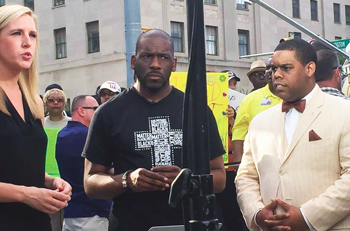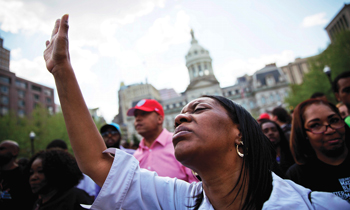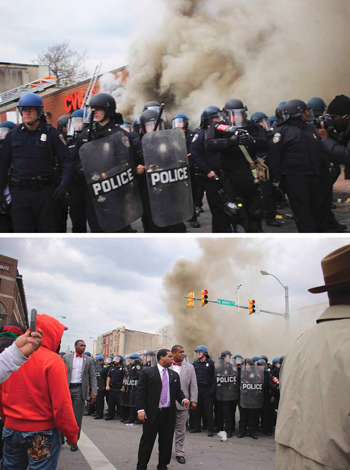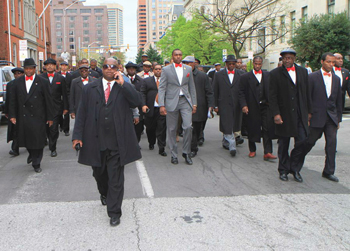Out of the ashes, hope for change in Baltimore
By Richard B. Muhammad | Last updated: May 5, 2015 - 10:54:50 AMWhat's your opinion on this article?

Rev. Jamal Bryant and Student Minister Carlos Muhammad during CNN interview. Photo: Final X
|
But it was unrest that set the stage for a renewed focus on longstanding problems of poverty, joblessness, hopelessness and an oppressive police force—conditions ignored and unanswered for decades.
“We have an opportunity to inspire a nation crying out for justice,” said Carlos Muhammad, student minister of Muhammad Mosque No. 6 in Baltimore.
“God is not going to be frustrated because of a few fires and turned over cars. He has put and anointed us with his spirit to restore, to heal a broken people,” said the Baltimore representative for the Nation of Islam and the Honorable Minister Louis Farrakhan to the crowd.
The May 3 afternoon gathering included religious leaders, Baltimore residents and others from along the East Coast and other parts of the country. The assembly in the shadow city hall, was a celebration of sorts as State’s Attorney Marilyn J. Mosby pressed charges against six city police officers in connection with the death of Freddie Gray in the Black and poor Sandtown neighborhood.
A couple days of unrest and children battling police officers with bricks and destroying police cars coupled with battles between marchers for justice and Whites in the treasured and lucrative downtown brought major concern.

Patricia Freeman prays during a rally in front of City Hall, May 3, in Baltimore. Hundreds of jubilant people prayed and chanted for justice days after the city's top prosecutor charged six offi cers involved in Freddie Gray's arrest. Gov. Larry Hogan called for a statewide "Day Of Prayer And Peace" on Sunday after civil unrest rocked Baltimore. Photo: AP/Wide World photos
|
An insurrection exploded in the city, which was followed by the arrival of the National Guard and a curfew. Businesses suffered and the image of the city took a beating, not to mention the temporary shutdown of a shopping center and destruction of a senior citizen housing building that was under construction. There were several hundred arrests, injured police officers and more devastation in an already suffering neighborhood. The curfew was lifted May 3.
But destruction brought the reality of ghetto suffering to the forefront of America’s consciousness, forcing presidential hopefuls and even President Obama to talk about the problems of discrimination, poverty, deprivation, police brutality and America’s division along lines of class and race.
“The rebellions in Ferguson and Baltimore are no more un-American than Bacon’s Rebellion in 1676, armed rebellion by Virginia settlers led by Nathaniel Bacon against the rule of Governor William Berkeley, or Shay’s Rebellion in 1787, protests by American farmers against tax collections and judgments for debt. The issues are basically the same,” Howard University political science professor Wilmer Leon told The Final Call.

Police offi cers in riot gear as pharmacy burns behind them. Photo: Final X (Bottom) Student Minister Carlos Muhammad in the streets as confl ict rages. Photo: Final X
|
“As Howard Zinn writes in A People’s History of the United States, ‘Were the Founding Fathers wise and just men trying to achieve a good balance … They certainly did not want an equal balance between slaves and masters, propertyless and property holders, Indians and white.’ That’s what we have today,” said Dr. Leon.
“The Baltimore Rebellion follows the natural laws of physics, Newton’s Third Law of Motion, and it is the language of the unheard,” he continued. “More simply put, when police officers treat a community that they are sworn to protect and serve as enemy combatants, the community will rebel. When a people see a police force that is supposed to protect and serve them turn into an occupying force, they will revolt,” he said.
“What we are seeing is not a new phenomenon,” said Dr. Conrad Worrill, director of Northeastern Illinois University and professor at the Carruthers Center for Inner City Studies. “Generally the police and the Black community have had a shady relationship since the end of the Civil War when Black men were leaving plantations with abolitionists. When they would walk down the street they were arrested for vagrancy.”
“This started the policing of the Black community. In 1919, the Red Summer, race riots that occurred in more than three dozen cities when Whites attacked Blacks, saw civil disorder all over the United States. Periodically these clashes resulting from police brutality and police misconduct have produced what you see in Baltimore,” he added.

Fruit of Islam move through streets of Baltimore. Photo: Ulysses Muhammad
|
City leaders and activists are pushing for change and for assistance, but the question remains what kind of assistance will come and when? Student Minister Muhammad urged the Black community to unite, pool its own resources and create opportunity. These abandoned rowhouses should be purchased with Black youth able to buy and rehab the properties, he said. Build your own supermarket, he added. You will never destroy what you own, Min. Muhammad said.
Others are looking for federal and state help alongside corporate investment and hoping the country will find an opportunity to face its fractured social conditions and apply solutions.
Pastor Julian Rivera of Fulton Baptist Church, which was surrounded by unrest but spared, hopes it will be easier to get partnerships to help the neighborhood. He was standing outside his church as members gave away water, toiletries and disposable diapers. Rebuilding will be a long process, Pastor Rivera admitted. He was undaunted.
Food programs, job training and education programs are needed, he said. With national light on Baltimore, he feels some opportunities between churches and corporations will open up. He tried unsuccessfully before to tap resources but “now their doors are open, their hearts are open.”
The items he gave away came from the police department and were donated by a major corporation tied to the city. It is unfortunate that is took unrest to bring attention, but I am grateful for the attention and possibility, the pastor said.
“It was a powder keg waiting to explode and people without hope do that sometimes. Our job is to bring hope so that that powder keg doesn’t blow up again,” he said.
Rev. Jamal Bryant, speaking at the downtown rally, called for residents to register to vote and get involved, saying turnout for the last election was less than 15 percent. He called on faith leaders and houses of worship to get involved and for public officials to prepare to be held accountable. The majority Black city has a Black mayor, Black police chief, Black city council president and almost half of the police officers are Black.
Baltimore also has a longstanding and destructive love affair with heroin, drug problems, and one of the highest murder rates in the county. Sandtown-Winchester, where Freddie Gray ran and was caught by police, leads the state when it comes to numbers of people incarcerated. The city population is estimated at 626,848 and poverty is entrenched, officially stalking 25 percent of residents. Unemployment is a problem. In Sandtown-Winchester just 42 percent of residents had jobs. According to the Census Bureau, the median income for Baltimore residents was $41,385 in 2013. The school system is in trouble and thousands of residents could be without water because of an inability to pay their bills.
State Senator Catherine Pugh hopes change and help is coming. She was out in the streets after the initial unrest trying to keep calm. “I think Baltimore becomes symbolic of the conversations that need to take place and the call for investment in neighborhoods and communities. While we are proud of the investments that take place in our downtown areas, I think we’ve got to say to developers and those who are investing in different parts of Baltimore that you’ve got to invest in our neighborhoods as well,” she said.
(Nisa Islam Muhammad contributed to this report.)
INSIDE STORIES AND REVIEWS
-
-
About Harriett ... and the Negro Hollywood Road Show
By Rabiah Muhammad, Guest Columnist » Full Story -
Skepticism greets Jay-Z, NFL talk of inspiring change
By Bryan 18X Crawford and Richard B. Muhammad The Final Call Newspaper @TheFinalCall » Full Story -
The painful problem of Black girls and suicide
By Charlene Muhammad -National Correspondent- » Full Story -
Exploitation of Innocence - Report: Perceptions, policies hurting Black girls
By Charlene Muhammad -National Correspondent- » Full Story -
Big Ballin: Big ideas fuel a father’s Big Baller Brand and brash business sense
By Bryan Crawford -Contributing Writer- » Full Story






 Click Here Stay Connected!
Click Here Stay Connected!








